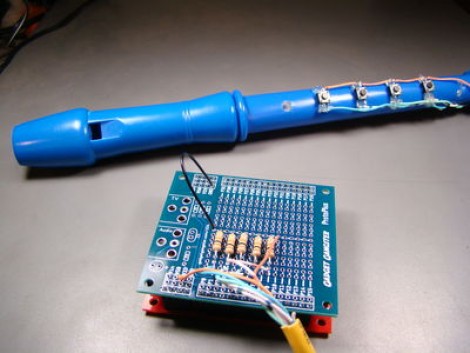
As we wrote the title to this feature we can see why [Jeff Ledger] calls it an electronic flute and not a recorder; this is a musical instrument and not something for archiving audio. Confusion aside, we’re all familiar with these plastic ‘musical’ instruments. Many elementary schools in our area require students to buy one as part of music class. So it shouldn’t be hard to find one if you want to try this for yourself (heck, [Jeff] grabbed his a the dollar store).
Basically, he’s replaced the finger holes with momentary press switches, then uses a Propeller dev board to turn the button presses into music. It’s simple and quick, but what does it for us is the breath actuator. Sure, you can set this up to play whenever a button is depressed, but [Jeff] went that extra mile and added a piezoelectric element to the bottom. When you blow through the instrument it flexes slightly, generating a tiny current that can be measured by the microcontroller. Check out the short clip after the break.
Do a little more work and you could turn this into some type of musical game controller. We’re thinking Zelda!
[youtube=http://www.youtube.com/watch?v=L8OU5mvgFHU&w=470]















Flute Hero any one? Though yes I would personally prefer Ocarina, how cool would it be to have to actually play the tune….
@Roman
Actually, I thought of that while I was building this! I almost put some colored vinyl tape between the switches to show the idea.
The Propeller running the synth could easily handle the video requirements from this which zero changes to the project. The AV board is already there. Just crank up some code.
I’m just going to leave this here.
http://www.youtube.com/watch?v=k7b-FTQeBw8
I friggin’ love that AMV. Cracks me up everytime.
Probably want to seal the actual sound hole so you can generate pressures easier and not get the actual recorder whistle.
Also would be neat to miniaturize the propeller and such and mount it entirely inside the device with only an audio output.
I’m a AMV HELL member and I approve this
hmm the piezo as blow sensor is interesting
not really like a recorder though since they only used 4 buttons, but still pretty cool
i was wondering what they were going to do with the two-holed holes and register hole..
in playing the recorder you can half cover the holes to get a differnt pitch
kind of surprised they went with the synth program rather than sending out midi, i guess this is why they’re using the propeller in case someone doesn’t have a midi setup (which isn’t really expensive for a basic midi-usb or even serial to midi in software, then use free midi synths)
Oh man. My friend made an ocarina like this last year. I’m going to have to get him to post it…
I did this for an electronic music class in 2002…I used a PIC16F874 to read the buttons and generate the tones, and an electret mic with peak detector circuit to activate the notes when blowing across the mic. Mounted it all in a PVC tube.
Up to 16 notes could be played with this simple button set. I have ocarinas that use a bastard binary fingering getting 12 notes, the full cromatic octave.
Ta-da.
Here’s an midi wind controller I built a couple of months back. Currently setup for saxophone fingerings, with a breath pressure sensor controlling the note on/off. Just need to get around to making my website and it’ll be open source for anyone.
Hit me up if you want the arduino code or circuit diagrams.
http://www.flickr.com/photos/37718515@N05/sets/72157627347525896/
and
http://www.youtube.com/watch?v=dvotIlBZKdg
that is mis named because a recorder is a device that captures some kind of data and stores it to some media like a audio cassette recorder takes sound and stores it on magnetic tape.
however with the setup you have you could have a recorder recorder if connected to a tape deck.
@ejonesss,
A recorder is also a flute like instrument, as mentioned in the OP.
Nice conversion! Clever thinking on the piezo element – did you put a windscreen on it?
There is a quite advanced version of such instrument made into a full fledged MIDI controller by some Bulgarian guys. You can see it here, there are a lot of other demo videos on youtube:
http://www.youtube.com/watch?v=dA4HU9HM4Ck&feature=related
that is freaking awesome!
I would think a small propeller could be used to detect how much air flow is going through the recorder. The generator (small electric motor?) would create enough resistance to slow the prop down quick enough to measure the air flow accurately.
@nikescar
how about an optical rotary encoder with the propeller?
less friction
FYI ‘flute’ doesn’t always mean ‘transverse flute’. It’s a class of instrument and the recorder falls in that class. It is a valid name!
Ask a European what they call the instrument. They will say ‘flute’, ‘blockflote’ etc.
I’m weirded out by the coincidence. I’ve spent the last few months working on a MIDI ocarina conversion very similar to this.
All I found online were some unfinished attempts, and the commercial Yamaha and Akai EWIs, but nothing quite like what I had in mind. And now I see this post and comments… good resources here, though.
A propeller + optical encoder would have too much inertia to be responsive enough for a wind controller.
BTW, there’s also this flute conversion:
http://www.youtube.com/watch?v=AXNIQJvz6_M